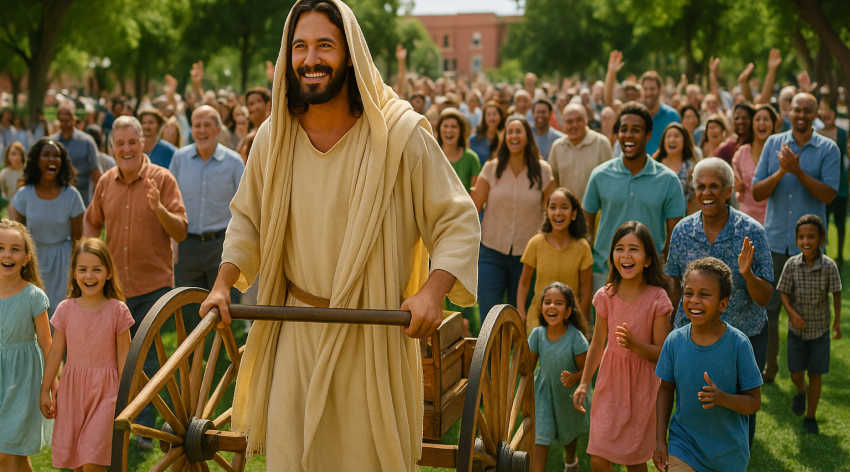Where did the Term PIONEERS Come From?
The migration of Brigham Young and the Mormon people to Utah is rooted in a complex history of persecution, theological evolution, and political conflict, often portrayed differently in official Latter-day Saints (LDS) narratives compared to critical historical accounts. Here’s a synthesis of the events, emphasizing discrepancies between LDS depictions and external sources, as well as modern efforts to manage controversial aspects of the church’s past:
The Exodus from New York, Missouri, and Illinois: Persecution vs. Provocation
“But you, beloved, ought to remember the words that were spoken beforehand by the apostles of our Lord Jesus Christ, that they were saying to you, ‘In the last time there will be mockers, following after their own ungodly lusts.’ These are the ones who cause divisions, worldly-minded, devoid of the Spirit. But you, beloved, building yourselves up on your most holy faith, praying in the Holy Spirit, keep yourselves in the love of God, waiting anxiously for the mercy of our Lord Jesus Christ to eternal life.” Jude 1:17–21
LDS Narrative
The Church emphasizes religious persecution as the primary driver for relocation. Joseph Smith’s early followers faced hostility due to their unorthodox beliefs, such as polygamy, communal economics, and claims of divine authority. After Smith’s murder in 1844, Brigham Young framed the westward migration as a divine mission to establish a "Zion" free from persecution.
Critical Perspectives
- Missouri Conflicts: The 1838 Mormon War in Missouri is often attributed to anti-Mormon bigotry. However, tensions were exacerbated by Mormon settlers’ rapid growth, political aspirations (e.g., forming a theodemocratic "Council of Fifty"), and aggressive rhetoric. Sidney Rigdon’s "Salt Sermon" and Smith’s declaration of a "war of extermination" against dissenters inflamed local fears.
- Nauvoo, Illinois: Smith’s actions—including instituting polygamy, destroying the Nauvoo Expositor press (which exposed his secret plural marriages), and declaring martial law—led to his arrest and assassination. The LDS narrative minimizes Smith’s provocations, instead depicting him as an innocent martyr.
Whitewashing Examples
- The church’s Saints series (2018) downplays Smith’s polygamy and portrays the destruction of the Nauvoo Expositor as a defense against "lies," omitting that the paper accurately reported his secret marriages.
- Early LDS histories omitted Smith’s 1844 presidential campaign, which included radical proposals like federal abolition of slavery, further alienating non-Mormons.
Brigham Young’s Leadership and the Utah Settlement
LDS Narrative
Young is celebrated as an "American Moses" who led the Saints to safety in the Salt Lake Valley, guided by divine revelation. The 1847 migration is framed as a heroic exodus to fulfill Smith’s vision of a refuge in the Rocky Mountains.
Critical Perspectives
- Young’s authoritarian governance included enforcing polygamy, suppressing dissent, and orchestrating violent acts like the Mountain Meadows Massacre (1857), where Mormon militiamen slaughtered 120 Arkansas emigrants. LDS accounts initially blamed Native Americans and scapegoated John D. Lee, obscuring Young’s complicity.
- Young’s theodemocracy in Utah involved controlling politics, economics, and social life, including slavery (legalized via the 1852 Act in Relation to Service) and exclusion of Black men from priesthood until 1978.
Whitewashing Examples
- The church’s Gospel Topics Essays (2013–present) acknowledge the massacre but frame it as a "local" event, avoiding direct blame on Young.
- Early 20th-century materials omitted Young’s adamant support for slavery and racial segregation, later attributing the priesthood ban to "theories" rather than doctrine.
Joseph Smith’s Legacy and Modern Church Revisions
LDS Narrative
Smith is venerated as a prophet who restored true Christianity. Church materials highlight his First Vision, Book of Mormon translation, and martyrdom while minimizing controversies like polygamy or failed prophecies.
Critical Perspectives
- Polygamy: Smith married at least 34 women, including teenagers (e.g., 14-year-old Helen Mar Kimball) and wives of missionaries sent abroad. The church’s 2014 essay admitted this but framed it as a "commandment" from God, avoiding discussions of coercion.
- Translation Methods: The Book of Mormon’s origin story shifted from Smith using "seer stones in a hat" (acknowledged in 2015 essays) to earlier depictions of him using the Urim and Thummim, a more biblically resonant tool.
- First Vision Accounts: The church concealed Smith’s conflicting First Vision narratives (e.g., an 1832 version mentioning only Jesus) until critics exposed them in the 1960s. The Joseph Smith Papers project later published these documents.
Modern Concealment Tactics
- Controlled Access: The church restricts access to sensitive archives, as seen in the 1985 Mark Hofmann forgery scandal, where leaders sought to purchase documents to suppress damaging narratives.
- Excommunication of Scholars: Historians like Fawn Brodie (No Man Knows My History) and D. Michael Quinn were excommunicated for publishing unvarnished accounts of Smith’s polygamy policies.
- Gospel Topics Essays: These cautiously admit past issues (e.g., race-based priesthood bans) but frame them as "past policies" rather than doctrinal errors, preserving institutional authority.
A Tension Between Truth and Faith
The LDS Church’s historical narrative prioritizes faith promotion over factual transparency. While recent efforts (e.g., Joseph Smith Papers) show incremental openness, critical events like Smith’s polygamy, Young’s violence, and systemic racism remain sanitized to protect the church’s image. As ex-member critics note, the institution’s survival depends on balancing historical accountability with doctrinal infallibility—a tension unresolved in its 21st-century rebranding.
“For he is not a Jew who is one outwardly, nor is circumcision that which is outward in the flesh. But he is a Jew who is one inwardly; and circumcision is that which is of the heart, by the Spirit, not by the letter; and his praise is not from men, but from God.” Romans 2:29


